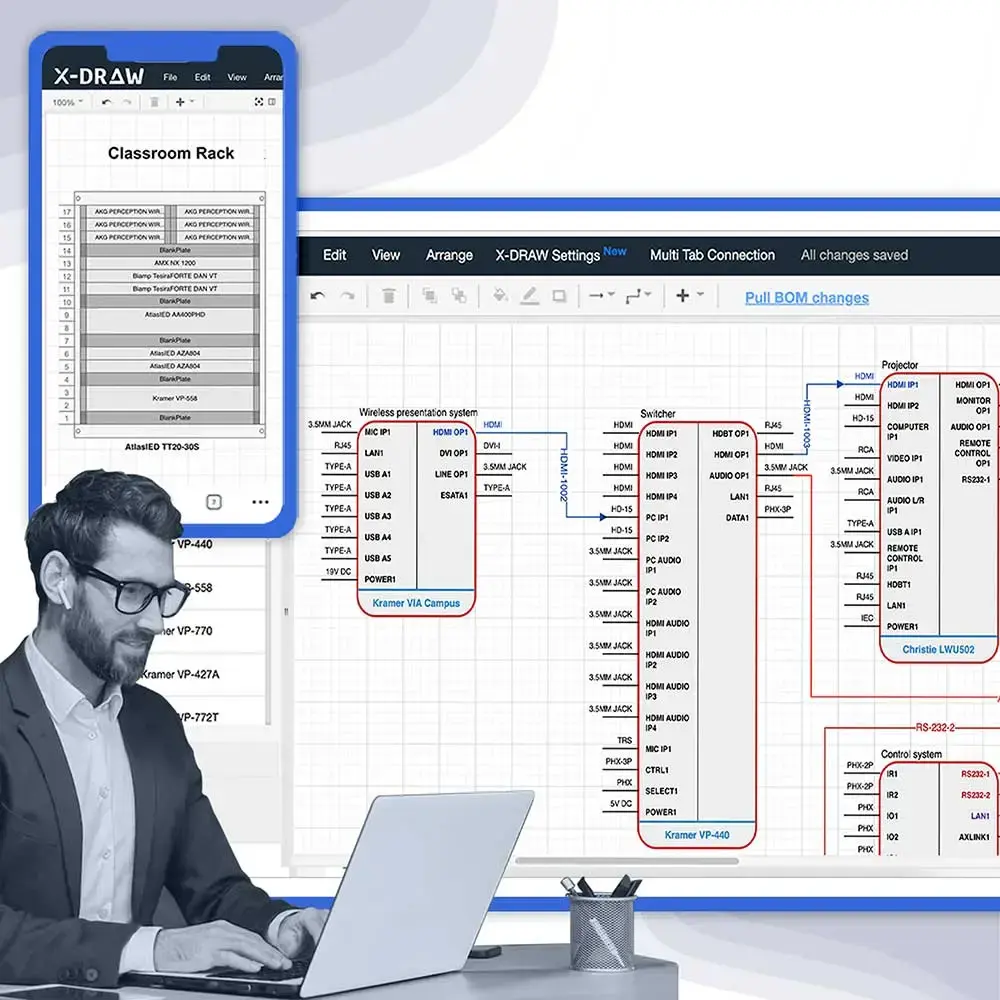6 Strategic Cable Management Tips: Enhancing AV Aesthetics and Functionality
Welcome to the world of AV technology, where each wire and connection has the potential to transform any space into an immersive experience. Cable management plays a role in achieving that clutter-free look that professionals strive for in high-end installations. Not only does it enhance performance and safety. It also saves precious troubleshooting time. Today we will embark on a journey through the practices in cable management for the AV industry uncovering the secrets that industry veterans swear by.
Did you know that following AV cable management best practices can improve signal quality by up to 40%? We will explore techniques to conquer the cable jungle and take your AV setup to heights. Get ready to revolutionize your installations and elevate your AV experience!
6 Tips For AV Cable Management
A well-organized AV setup is not only appealing to the eyes, but it is also much easier to manage. It is really important to sort out the cable management process because at a later stage, when you want to change anything, it becomes difficult to identify. So here are some tips that will help you manage your cables like a pro.
The "Bundling Buddy" Technique
Opting for cable ties or Velcro straps can make a difference in cable management. Not only does it maintain an appearance but it also allows for effortless adjustments. By managing cables, you can reduce the chances of accidents by up to 25%.
Master the Art of Cable Labeling Systems
Avoid situations where the wrong cable is accidentally unplugged and potentially disrupts the cable labeling system by labeling your cables. A simple label maker or colored tape can work wonders in this regard. According to a survey conducted by AV professionals, proper labeling can save you up to 20 minutes in troubleshooting sessions.
XTEN-AV Tip: Ensure top-notch cable management with our Automatic Cable Labeling feature that ensures artful Integration & Installation! Learn more about the feature and more here.
Embrace Raceways
Raceways, which are metal channels designed to hide and protect cables are essential for achieving an organized setup. Interestingly, using raceways can also decrease wear and tear on your cables by up to 65%.
Follow the Zigzag Rule
When routing cables along walls or floors employ the “Zigzag Rule.” Running them creates gentle and alternating curves. This does not enhance aesthetics. It also reduces tripping hazards by around 30%.
Elevate and Separate
Use cable clips, adhesive-backed mounts, or hooks to elevate your cables from the floor surface. Additionally, it’s advisable to keep power cables separate from signal cables.
This feature decreases the impact of interference (EMI), by 40% resulting in a more refined audio and video signal.
Prepare for the future by considering capacity
Opt for cable management solutions that can accommodate devices that you currently have. This way when you eventually add devices you won’t have to start from scratch and rearrange everything. Studies show that planning ahead like this can result in long-term savings of, up to 40%, on installation costs.
XTEN-AV Tip: Project scalability is an attribute of the software used to collaborate from design conceptualization to installation. Ensure seamless collaboration with cloud-based software!
AV Design Mastery + Winning Proposals = 10x Productivity!
- Automatic Cable Labeling & Styling
- 100+ Free Proposal Templates
- Upload & Create Floor Plans
- 1.5M Products from 5200 Brands
- AI-powered ‘Search Sense'
- Legally Binding Digital Signatures
Cable Management Considerations For AV Over IP
Remember, a well-planned AV over IP system can revolutionize your audio-visual experience, providing you with unmatched flexibility and scalability. These considerations will set you on the right path to achieving just that.
- Bandwidth reigns supreme in the realm of AV over IP. It is essential to ensure that your network has the capacity to handle the data load. Consider utilizing Gigabit Ethernet or even higher speed networks for performance. Just a little fact; Streaming 4K video typically necessitates a bandwidth of 25-35 Mbps.
- Don’t underestimate the importance of Quality of Service (QoS). Implementing QoS protocols on your network can prioritize AV traffic guaranteeing that your audio and video streams receive the bandwidth. This will significantly enhance your AV experience.
- Scalability and flexibility are advantages offered by AV over IP. Make sure your infrastructure is designed to accommodate expansions. Invest in switches that support AV endpoints and have room for growth. This flexibility will save you from undergoing an overhaul.
- When it comes to compression and latency considerations, think about your AV requirements. Higher compression rates can reduce demands. May introduce some latency issues. On the other hand, low latency might require bandwidth usage. Striking the balance is crucial here.
- Lastly don’t overlook security when dealing with AV over IP as it relies heavily on network security measures. To protect your data make use of encryption protocols such as Secure Sockets Layer (SSL) or Transport Layer Security (TLS). Moreover it is advisable to set up LANs (VLANs) to separate AV traffic from network traffic. This will enhance the security measures in place.
The Different Types Of Cable Management Solutions
There are a variety of options for managing cables, including shapes, sizes and materials to meet various needs and environments. By selecting the combination of these solutions you can create a well-organized and efficient cable setup for any space.
Cable Raceways and Ducts
- These are channels or enclosures that hide and protect cables while providing an organized appearance.
- They are suitable for both surface-mounted installations and in-wall setups with sizes and materials to accommodate different environments.
Cable Ties and Wraps
- These fasteners help keep cables secure by preventing them from tangling or becoming disorganized.
- They come in materials such as nylon, Velcro, and reusable options to offer flexibility for different setups.
Cable Clips and Clamps
- Designed to hold cables in place clips and clamps can be attached to surfaces like walls, desks, or av racks.
- They are useful for managing bundles of cables within an area while keeping them organized.
Cable Management Trays and Racks
- These larger systems provide a framework for routing and organizing cables.
- Commonly used in server rooms or data centers they allow placement of a number of cables while providing easy access.
Cable sleeves and spiral wraps serve the purpose of organizing and safeguarding cables resulting in an organized look. While sleeves are tubes that can expand spiral wraps are coiled covers specifically designed to manage cables or smaller groups of cables.
Conclusion
We now understand that organizing cables is more than about making things look good. It’s about unlocking the potential of your AV systems. By following these strategies, you not only achieve a professional appearance but also improve performance and safety.
With the understanding of how a structured cable setup can enhance signal quality, reduce troubleshooting time and create an environment overall, what steps will you take to revolutionize your AV installations? How do you plan to apply these techniques to your projects? The power to enhance your AV experience is in your hands. Embrace these recommended practices. Let your installations shine!
Frequently Asked Questions (FAQ's)
In the AV sector, cable management is critical for safety, efficient airflow, rapid issue response, and a professional appearance. It eliminates tripping risks, protects cables, and encourages optimal ventilation, which minimizes overheating and equipment damage. Clients are also left with a positive image of a well-managed establishment.
Cable labeling must be precise and straightforward for effective cable management. For identification, invest in a dependable label maker or use colored tape. Label the cable with the source, destination, and signal type on a regular basis. Heat-shrink labels provide a long-lasting, professional look.
Use raceways, conduits, and cable trays to secure wires in complicated AV systems, cable management panels and racks to organize connections, and cable ties, Velcro straps, or lacing bars for tidy bundling. Leave excess capacity in conduits and racks to allow for future scaling.
To safeguard data transfer, AV systems necessitate robust network security, which includes encryption methods such as SSL or TLS, firewalls, access restrictions, and virtual LANs. Regular firmware and software upgrades are required to fix vulnerabilities and remain safe from possible attacks.

